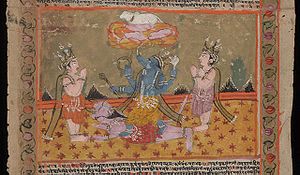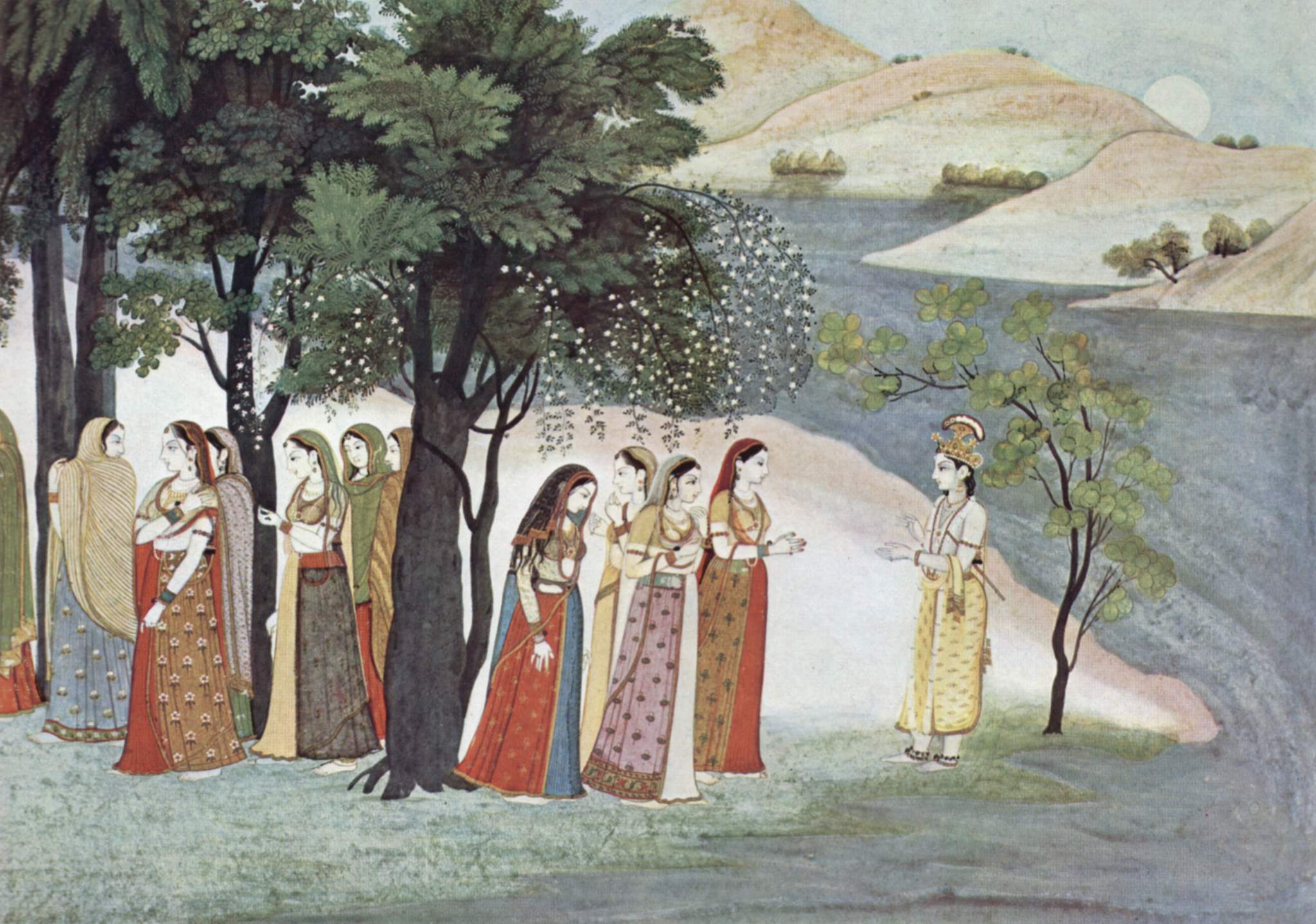The Puranas make several comments in relation to the hollow Earth which should not be taken lightly. Although they are but comments in passing, their significance should be recognized. One such Puranic comment has to do with the narration of the Kalki avatar- that at the end of Kali Yuga, the Kalki Avatar will be born in the best of Brahmin families of the city of Shamballa to annihilate miscreants on the surface of the globe.
Afterward, the general Puranic version goes that Vedic culture will be re-settled on the surface of the Earth from the interior of the planet. It is noteworthy that Shamballa is depicted in the Puranas as a city of the planet’s interior. Not only in the Puranas, but in Tibetan collective memory also, Shamballa is deemed to be a city in the Earth’s interior.

There are other prominent Puranic stories that openly make reference to the hollow portion of the Earth such as the one relating to the avatar Parasurama, and may be found in the Ninth Canto, Sixteenth Chapter, Texts 19 – 21, of the Bhagavatam Purana.
The 19th text says that He confronted the warrior caste 21 times and rid the face of the Earth of them.
The word Prithivim was used to indicate the “face“ of the Earth. Then it is explained that Parasurama distributed the eight points of the compass to certain rishis. This only makes sense as was rather disgusted with the warrior caste. Rishis are different than warriors, of course- they are members of the priestly caste.
For example, they are tolerant, intellectual, they practice goodness, etc. After mentioning the eight points of the compass and the rishis who received lordship over these areas, the ” madhyayatah “, the middle portion, was then mentioned; the Bhagavat Purana says that the middle portion was distributed to Kashyapa Rishi. So while adopting a descriptive tone of narration, and after having mentioned the surface or the ” face ” of the world, the Bhagavata Purana went on to contrast by mentioning the middle portion, practically in the same breath. The wording and storyline of this narration about the avatar Parasurama are directly indicative of the Hollow Earth Theory.
And yet another is the story of the sons of Maharaj Sagara. It seems that Indra had stolen the sacrificial horse meant for the Ashvamedha sacrifice ( a type of fire sacrifice ). As the story goes, the sons of Sagara went searching after the horse and came to a Northern ocean, which they traveled over, and entered into the interior of the Earth. There, they found the horse at the hermitage of Kapila Rishi.
The sons of Sagara manhandled the rishi even though he swore that it wasn’t him who had stolen the horse. What can we conclude from this story? Well, first of all, because they manhandled a rishi, we can conclude that the sons of Maharaj Sagara were a rough bunch indeed! On a more serious note, though, a correspondence exists in that hollow Earth investigators indicate the existence of openings near the polar areas of this planet ( and support such allegations with various evidence, for example, Polar anomalies such as warming ).
This would account for having to cross a Northern ocean in order to enter into the interior of the planet. The Bhagavat Purana doesn’t go into as much description as other Puranas do; the Bhagavat just says that the sons of Sagara went in the Northeast direction. But even this statement seems to confirm the placement of the opening by hollow Earth investigators, who place it to the North and to the East of the Russian peninsula Severnaya Zemlya.
How interesting it is that in order to reach this area from India, one would have to travel Northeast! Another noteworthy point to be gleaned from this narration is that Vedic culture existed in the hollow Earth, as none other than Kapila Rishi had his hermitage there. How congruent with the descriptions given by Olaf Jansen, the Norwegian youth who claimed to have wandered into the opening with his father on their sailboat. Olaf described a human society which seemed to correspond to Puranic descriptions from before the start of the Kali Yuga.
He described humans being 12 to 14 feet tall, with life spans of almost 1,000 years, photographic memories, who spoke Sanskrit and worshipped the Sun, albeit the interior sun. An obvious question arises, however- why don’t the Puranas just come out and explain to us about the hollow Earth, then? Well, remember that these Puranas were originally compiled at the juncture between two yugas, before the effects of the Kali Yuga, such as forgetfulness and ignorance, had completely come to manifest. Maybe it is for this reason that the Puranas speak of the hollow Earth in such a way that they assume people naturally know about it, and therefore don’t offer any special explanations.
By way of analogy, if a writer were to narrate the story of the deciding battle of the American Revolution, the Battle of Yorktown, he or she might explain that the French cut off any possible retreat by the British by way of the sea; and then the writer would probably go on with the story. But the writer would assume that the reader knows who the French are and that they come from the other side of the Atlantic Ocean, and that such an ocean indeed exists.
It would not occur to the writer to try to explain and substantiate the existence of the French people or of the ocean in the middle of the narration, obviously. It seems that, similarly, the Puranas simply mention the “ bowels “ of the Earth and Kapila Rishi’s hermitage there in the course of their narrations, without offering any special explanations. But the Puranic evidence is actually of much interest to the adherents of the Hollow Earth Theory; it actually constitutes a landmark addition to the body of hollow Earth evidence.
This is interesting because the Tibetan lore referring to the hollow Earth became popularized among the proponents of the theory a long time ago, even spawning a major motion picture production entitled “ Shangri La “ in the 1930s, which was re-done in the 70s. Maybe this was due to the impact of a book written by Nicholas Roerich entitled simply “ Shambhalla,” which was published in 1930. He had traveled in Tibet and related the rich hollow Earth folklore in his book, which mentions the cities of Shamballa, Shangri La, and the kingdom of Agharta.
Quite possibly the Tibetan hollow Earth collective memory has been better conserved because of the tunnels that are said to run between Agharta and Tibet- it is possible that the Tibetans received influence from the hollow Earth for a longer period of time for this reason. The Puranic hollow Earth content hasn’t been much recognized because we in the West have always experienced the Puranas through the filter of Westernized Indologists, who weren’t much aware of hollow Earth folklore, nor were they exactly looking for clues about the true geological configuration of our planet as they went about their studies of the Vedic literature.
These comments about the hollow Earth must have passed them by, as did a lot of comments in the Vedic literature. When the British first studied the Vedic literature after their invasion into India 200 years ago, they noticed comments about things such as aircraft ( vimanas ), arrows and disks which were able to pursue fleeing targets, weapons born of mantras, as well as beings from other planets with incredible life spans who were identified as the progenitors of humanity. Well, the British naturally disregarded such comments as poppycock. But now we have seen some of these things come true; we have seen the advent of flight, guided missiles, and voice-activated weapons.
Thus it might behoove followers of Vedic dharma to revisit the Puranic narrations with a wide-angle lens- These comments about the bowels of the Earth, the hermitage of Kapila Rishi, the Parasurama Avatar and about Shambala certainly merit specific focus.
